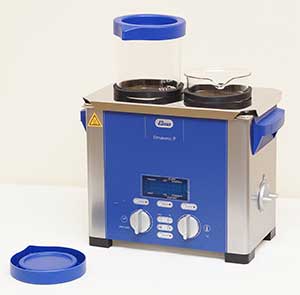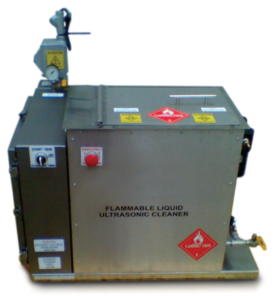How to Ultrasonically Clean Epoxy Dispensing Nozzles
Epoxy resin adhesives used in manufacturing liquid crystal display (LCD) screens and similar applications are applied to surfaces with automated dispensing machines through precisely machined nozzles.
As an example a nozzle can be 2.5 cm long with a 0.2 to 0.5 mm diameter tip at the point of dispensing. It is affixed into an approximately 80 x 60 x 50 mm module that receives epoxy by pneumatic pressure.
During the process the epoxy temperature is high enough to keep it liquefied. At the end of a cycle it quickly solidifies in the module and nozzle and must be removed.
Cleaning is performed daily after equipment shut-down. Manually scrubbing these assemblies is unsatisfactory for two reasons:
- it is not thorough, resulting in substandard epoxy application and
- it can damage the precise nozzle configuration.
How Ultrasonic Cavitation Delivers Fast, Safe, Epoxy Dispenser Cleaning
In contrast to mechanical scrubbing an ultrasonic cleaner is proven highly effective in cleaning adhesive dispensing systems immersed in cleaning solvent.
Cleaning is accomplished by minute vacuum bubbles imploding on dispensing nozzle and module surfaces to dissolve epoxy residues. Bubbles are created by ultrasonic transducers powered by a generator and are small enough to reach all wetted surfaces.
Due to the nature of the epoxy a solvent such as isopropyl alcohol (IPA) rather than an aqueous cleaning solution is used. But because IPA is flammable steps must be taken to avoid the danger of fumes causing an explosion or fire. This means you must check with your plant safety personnel and local public safety organizations to assure your installation will meet requirements.
Two Systems for Cleaning Epoxy Dispensing Nozzles
There are two generally accepted procedures for safely cleaning parts with IPA in an ultrasonic cleaner.
One uses a standard benchtop ultrasonic cleaner such as the Elmasonic P series in company with beaker kits.
The other uses an explosion-proof cleaner such as the SOL XP series available in tank sizes from 4 to 33 gallons. Both are available from Tovatech.
Using the Elmasonic P Ultrasonic Cleaner

Dual-frequency 37 and 80 kHz Elmasonic P cleaners with adjustable power control are available in 6 tank capacities from 0.5 to 7.5 gallons. These units must be placed in a location with venting and in compliance with other safety requirements noted above.
Fill the tank with tap water, add a surfactant then activate the degas function to drive off air.
With this method nozzles and modules are placed in a beaker and immersed with IPA. Cover the container loosely to minimize the vapor that will result during the cleaning process. A loose-fitting cover is important because tightly sealed containers could crack from expansion due to heat generated during ultrasonic cavitation.
Beakers can be supported using the beaker kit cover. This allows you to immerse the bottom 1 to 2 inches of the beaker in the water.
Set the timer for 15 minutes and start the ultrasonic cleaning cycle at 37 kHz.
Fine tune the power, frequency and time settings by trial and error. A larger load typically requires more power.
During this process ultrasonic energy penetrates the beaker walls and cavitation action will occur in the IPA, where epoxy is dissolved. At the conclusion of the process carefully remove the nozzles and modules, rinse them in clean IPA and use a blower for residue-free drying.
Using the SOL XP Explosion-Proof Cleaner
If nozzle and module cleaning is an ongoing operation explosion proof ultrasonic cleaners such as the SOL XP models might prove more practical.

SOL XP 54 models provide the ultrasonic power density of the largest industrial systems.
Designed for use in Class I Division 1 hazardous areas they are fully nitrogen inerted for fire protection, ETL approved as sold, with no additional approvals required.
(That said, it is always good practice to discuss the installation of any cleaning system involving volatile solvents with your plant safety personnel and local public safety departments.)
Here’s a suggested cleaning procedure geared for fast evaporating IPA. It can be refined based on your own experience.
- Position parts in the wire mesh cleaning basket (sold separately).
- Add IPA to the cleaning tank fill line and operate the ultrasonic power for 15 minutes to degas the solvent.
- Lower the basket into the IPA solvent and set the timer for 15 minutes. The unit will turn off at the end of the cycle.
- When cleaning operations are completed drain off and save the solvent in an air tight container. If you do frequent cleaning with IPA consider investing in a solvent recovery system.
To expand further on points suggested above, precautions against fire should be taken any time you handle IPA. In addition to the fume hood the SOL XP cleaning area should have explosion-proof electrical fixtures. Personnel in the vicinity of the cleaning operation should not carry electronic devices that could cause a spark.
In conclusion, the costs of epoxy nozzle dispensing assemblies and manual cleaning operations make investing in an ultrasonic cleaning system an attractive alternative to replacing them. The technical staff at Tovatech is ready to help you evaluate systems based on your cleaning requirements.

